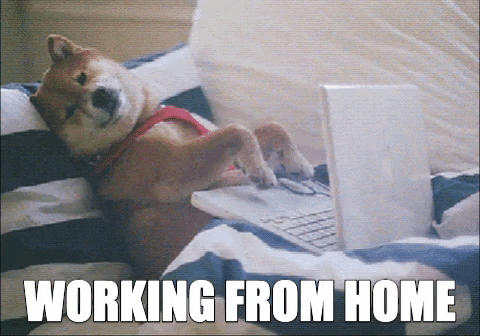Remote Work Works So Well That I Don’t Want To Go Back To The Office

Remote work isn’t a new concept. Telecommunications has been around since the 1980s when the internet was first utilized for business purposes. However, it wasn’t until the 2000s when in-home internet was popularized that remote work started to take off.
The idea of remote work has always been enticing but not necessarily practical. It’s clear how reduced commute time, a larger talent pool, and increased employee satisfaction can lead to a more productive business. But as a leader, it hasn’t always been easy to let go of the hypothetical reins, until now.
Covid-19 has forced thousands of businesses to adjust their strategies, workflows, and processes. And, remote work is a major part of the changing landscape.
So, if you’re a part of the newly-remote workforce, read on to learn how to make home employment work so well that you won’t want to go back into the office.

Structure Your Mornings
Yes, I know it’s easy to fall into the trap of rolling over in bed two minutes before work starts and opening your laptop (not that I’ve ever done that). If this sounds familiar, your days have probably begun to blend together, and you may be starting to question your existence. Well, maybe you aren’t questioning your existence, but you’re probably in a bit of a funk.
Structure is the ingredient that you don’t know you’re missing until it’s too late. When you’re forced to go into the office five days a week, you form routines. Humans are creatures of habit for a reason; it works.
I’m not saying that you need to wake up at 4:30 AM and go for a run every morning. But, treat your day like you normally would. Sleep in a bit (thank you no more commuting), then wake up and follow your normal routine. Brush your teeth, take a shower, drink a glass of water, drink a cup of coffee, and give yourself a minute to relax before your day starts. I like to sit outside for a few minutes while I take my dogs out in the morning. Our days are simply collections of actions leading to additional actions. When you start your day half asleep and rushed, that energy and trend will follow you for the entire duration of your day.

Structure Your Environment
Okay, now that you’ve given your morning a little structure, it’s time to give your work some structure. I’m not talking about the work your producing; I’m talking about your physical workspace. Designate a specific location in your home as a workspace. You don’t need a boujee home office to be productive. You just need some space to help get you in a flow state.
Most people have heard that it’s not good to watch television in bed. This is because it can confuse your body and make it hard to sleep when you want to be sleeping. The same holds true for your work environment. By designating a specific location as a workspace, you’re body and mind will know when it’s time to get to work. Additionally, a dedicated workspace will help you strike a barrier between the often lopsided work-life balance that comes with remote work.
If you’re looking for more information on designing a home office with productivity and comfort in mind, check out this helpful home office design guide!

Structure Your Work Hours
In a traditional office environment, when the workday is finished, employees head home. While working from home, it can be easy to ignore the clock and work past the traditional 9 to 5. On the surface, this doesn’t seem like a problem. But, when companies adopt telecommunication as a long term strategy, this can lead to employee burnout and poor results. Utilize your calendar and set reminders to help avoid burnout.

It’s Okay To Over-communicate
Communicate with your employees. Communicate with your co-workers. Communicate with your teams. Humans are social creatures, and we require human communication to thrive.
Even if you don’t have an immediate need to chat with someone, it’s important to touch base with the different members of your teams. Isolation and siloing of teams can become amplified during times of remote work. Schedule regular short meeting times to connect with your employees or co-workers. These don’t need to be lengthy meetings, but they’re good for promoting cross-collaboration and keeping everyone on the same page.

Utilize Different Communication Tools
Just like communicating in-person, everyone responds to separate actions and environments differently. Some people enjoy large crowds, while others panic in these types of situations. Some people enjoy physical contact, while others want to avoid being touched at all costs. We’re living in the 21st century, so take advantage of all of the communication tools at your disposal. Schedule phone calls, send text messages, hold group video calls, and send good ol’ emails. Learn your team members’ preferences and do your best to communicate using their preferred methods.

Trust Your Employees
In many ways, the steps to success in a remote world are very similar to those needed for success in an in-person environment. Creating structure, communicating effectively, and building trust are all vital components to a healthy and thriving workplace. So, how do we build trust? We build trust by giving it. Just like in-person management, it’s important not to micromanage remote employees.
When you’re at home, distractions are everywhere. Between barking dogs, nosey neighbors, and the arrival of Amazon packages, it can be easy to get side-tracked. Yes, this can temporarily derail productivity, but it can also lead to improved quality of life. As a manager, it’s vital you understand that distractions will occur, and to not overreact. Set large overarching goals and make sure your team meets their deadlines. This will give your employees the freedom to breathe while holding them accountable.
Daily communication is important, but micromanagement isn’t effective. Micromanagement can cause stress, poor work quality, and employee dissatisfaction. Instead, give your employees the freedom to pace themselves. Now, I know what you may be thinking, “But, I don’t trust my employees to work the entire time they’re on the clock. I need to micromanage in order to ensure their work gets done.”

If this is the case, you have a bigger issue to worry about. You most likely hired these employees, or you hired someone else who hired these employees. If you can’t trust them to manage their work time, you probably shouldn’t have them on your team. Additionally, if you don’t trust your employees, why should they trust you? As an employee or any person in general, it’s clear when someone doesn’t trust you. Give your employees freedom, or get rid of them.
Good luck, and stay healthy!

